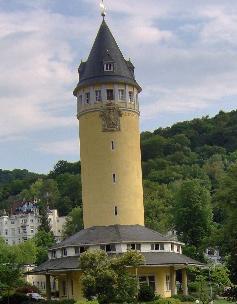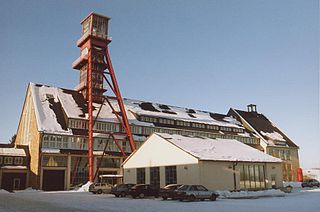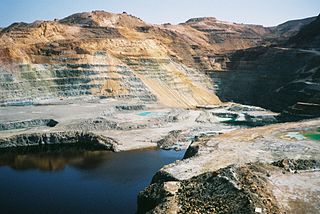

The German Oil Museum (German : Deutsches Erdölmuseum Wietze) or German Crude Oil Museum is located in Wietze, a small village west of Celle in Lower Saxony.


The German Oil Museum (German : Deutsches Erdölmuseum Wietze) or German Crude Oil Museum is located in Wietze, a small village west of Celle in Lower Saxony.
The exhibitions in the museum's buildings use a combination of text, diagrams and models to describe the origin, occurrence, prospecting, extraction, processing and uses of crude oil. In addition, the history of crude oil extraction and use, particularly in the region around Wietze, is vividly portrayed. On a site of about 2 hectares (4.9 acres) in size, old and modern technical installations used for extraction, prospecting and refining crude oil are exhibited. Occasionally there are mining shows at which objects associated with mining, minerals and fossils may be swapped, bought or sold.
In 2015 the museum began a major reorganisation of the layout which will culminate in a completely new permanent display in 2022. This included a full refurbishment in 2020 of the Wintershall drilling rig which had been moved there in 1988. [1] In 2021 it was announced that the museum was seeking recognition as an industrial heritage site. [2] [3] In the same year, the Lower Saxon State Office for the Preservation of Monuments entered the historic ensemble of oil production facilities in the museum grounds in its list of cultural monuments. These include four wooden winding towers and their accessories, a transport pump, measuring vessels and an oil tank. The reason for the protection was the importance of the equipment in the economic history of the oil industry in Germany. [4]
The museum is a founding member of the network of European Oil Museums. [5] and member of the European Route of Industrial Heritage (ERIH).
The village of Wietze has played a special role in the history of crude oil extraction. As early as the 17th century, crude oil from mineral deposits at Wietze was scooped from tar pits on the surface and used as a grease and medicament. In 1858 one of the first boreholes in the world for the extraction of oil was sunk here. From 1920 to 1963 oil was also extracted from underground mines.

Mining is the extraction of valuable geological materials and minerals from the surface of the Earth. Mining is required to obtain most materials that cannot be grown through agricultural processes, or feasibly created artificially in a laboratory or factory. Ores recovered by mining include metals, coal, oil shale, gemstones, limestone, chalk, dimension stone, rock salt, potash, gravel, and clay. The ore must be a rock or mineral that contains valuable constituent, can be extracted or mined and sold for profit. Mining in a wider sense includes extraction of any non-renewable resource such as petroleum, natural gas, or even water.

Petroleum is a naturally occurring yellowish-black liquid mixture. It consists mainly of hydrocarbons, and is found in geological formations. The term petroleum refers both to naturally occurring unprocessed crude oil, as well as to petroleum products that consist of refined crude oil.

DEA Deutsche Erdoel AG was an international oil and gas company headquartered in Hamburg, Germany. It was a subsidiary of L1 Energy. In 2018, DEA owned stakes in oil and gas licenses in various countries and operated natural gas underground storage facilities in Germany. DEA is a derivation from Deutsche Erdöl-Aktiengesellschaft, the original name of the company. On 1 May 2019, DEA merged with Wintershall to form Wintershall Dea.

The Rammelsberg is a mountain, 635 metres (2,083 ft) high, on the northern edge of the Harz range, south of the historic town of Goslar in the North German state of Lower Saxony. The mountain is the location of an important silver, copper, and lead mine. When it closed in 1988, it had been the only mine still working continuously for over 1,000 years. Because of its long history of mining and testimony to the advancement and exchange of technology over many centuries, the visitor mine of Rammelsberg was inscribed as a UNESCO World Heritage Site in 1992.

Mining in the engineering discipline is the extraction of minerals from the ground. Mining engineering is associated with many other disciplines, such as mineral processing, exploration, excavation, geology, metallurgy, geotechnical engineering and surveying. A mining engineer may manage any phase of mining operations, from exploration and discovery of the mineral resources, through feasibility study, mine design, development of plans, production and operations to mine closure.

Anthony Francis Lucas was a Croatian-born American oil explorer. With Pattillo Higgins, he organized the drilling of an oil well near Beaumont, Texas, that became known as Spindletop. This led to the widespread exploitation of oil and the start of the Petroleum Age.

A drilling rig is an integrated system that drills wells, such as oil or water wells, or holes for piling and other construction purposes, into the earth's subsurface. Drilling rigs can be massive structures housing equipment used to drill water wells, oil wells, or natural gas extraction wells, or they can be small enough to be moved manually by one person and such are called augers. Drilling rigs can sample subsurface mineral deposits, test rock, soil and groundwater physical properties, and also can be used to install sub-surface fabrications, such as underground utilities, instrumentation, tunnels or wells. Drilling rigs can be mobile equipment mounted on trucks, tracks or trailers, or more permanent land or marine-based structures. The term "rig" therefore generally refers to the complex equipment that is used to penetrate the surface of the Earth's crust.

Bad Ems is a town in Rhineland-Palatinate, Germany. It is the administrative seat of the Rhein-Lahn rural district and is well known as a spa on the river Lahn. Bad Ems was the seat of Bad Ems collective municipality, which has been merged into the Bad Ems-Nassau collective municipality. The town has around 9,000 inhabitants.

Mining in Japan is minimal because Japan does not possess many on-shore mineral resources. Many of the on-shore minerals have already been mined to the point that it has become less expensive to import minerals. There are small deposits of coal, oil, iron and minerals in the Japanese archipelago. Japan is scarce in critical natural resources and has been heavily dependent on imported energy and raw materials. There are major deep sea mineral resources in the seabed of Japan. This is not mined yet due to technological obstacles for deep sea mining.

The Zollverein Coal Mine Industrial Complex is a large former industrial site in the city of Essen, North Rhine-Westphalia, Germany. The first coal mine on the premises was founded in 1847, and mining activities took place from 1851 until December 23, 1986. For decades, starting in the late 1950s, the two parts of the site, Zollverein Coal Mine and Zollverein Coking Plant, ranked among the largest of their kinds in Europe. Shaft 12, built in the New Objectivity style, was opened in 1932 and is considered an architectural and technical masterpiece, earning it a reputation as the "most beautiful coal mine in the world".
Hydrocarbons are the leading sector in Algeria's mineral industry, which includes diverse but modest production of metals and industrial minerals. In 2006, helium production in Algeria accounted for about 13% of total world output. Hydrocarbons produced in Algeria accounted for about 2.9% of total world natural gas output and about 2.2% of total world crude oil output in 2006. Algeria held about 21% of total world identified resources of helium, 2.5% of total world natural gas reserves, and about 1% of total world crude oil reserves.

The impact of the petroleum industry has been increasing globally as the People's Republic of China ranks seventh for oil production and second in crude oil consumption in the world. China became the world's largest oil importer in 2013.

The following outline is provided as an overview of and topical guide to mining:

Mining in the United Kingdom produces a wide variety of fossil fuels, metals, and industrial minerals due to its complex geology. In 2013, there were over 2,000 active mines, quarries, and offshore drilling sites on the continental land mass of the United Kingdom producing £34bn of minerals and employing 36,000 people.

The Ore Mountain Mining Region is an industrial heritage landscape, over 800 years old, in the border region of the Ore Mountains between the German state of Saxony and North Bohemia in the Czech Republic. It is characterised by a plethora of historic, largely original, monuments to technology, as well as numerous individual monuments and collections related to the historic mining industry of the region. On 6 July 2019, the Erzgebirge/Krušnohoří Mining Region was inscribed as a UNESCO World Heritage Site, because of its exceptional testimony to the advancement of mining technology over the past 800 years.

The mining industry of Libya does not contribute significantly to its economy. Mining resources are located in remote regions with limited accessibility. The fuel sector, including oil reserves and natural gas is the major revenue-generating industry.

South Sudan is one of the African countries known as an important oil producer, whereas, South Sudan also has mineral resources like copper, gold, diamonds, limestone among others. Government is promoting investment particularly in exploration and also developing the mining projects in South Sudan.

The mining industry of Cyprus is synonymous with copper extraction which began around 4,000 BC. Copper dominates the mining sector along with mining of iron pyrite, gold, chromites and asbestos fibers, bentonite, cement, and also petroleum. Though at one time, copper was a mainstay of the economy, as of 2012, the mining sector does not contribute in a significant way to the GNP.

The mining industry of Yemen is at present dominated by fossil mineral of petroleum and liquefied natural gas (LNG), and to a limited extent by extraction of dimension stone, gypsum, and refined petroleum. Reserves of metals like cobalt, copper, gold, iron ore, nickel, niobium, platinum-group metals, silver, tantalum, and zinc are awaiting exploration. Industrial minerals with identified reserves include black sands with ilmenite, monazite, rutile, and zirconium, celestine, clays, dimension stone, dolomite, feldspar, fluorite, gypsum, limestone, magnesite, perlite, pure limestone, quartz, salt, sandstone, scoria, talc, and zeolites; some of these are under exploitation.

The Niitsu Oil Field is the collective name for an oil extraction zone distributed in the southeastern hills of Akiha-ku, Niigata, Japan, covering an area of approximately 6 kilometers in width by 16 kilometers in length.